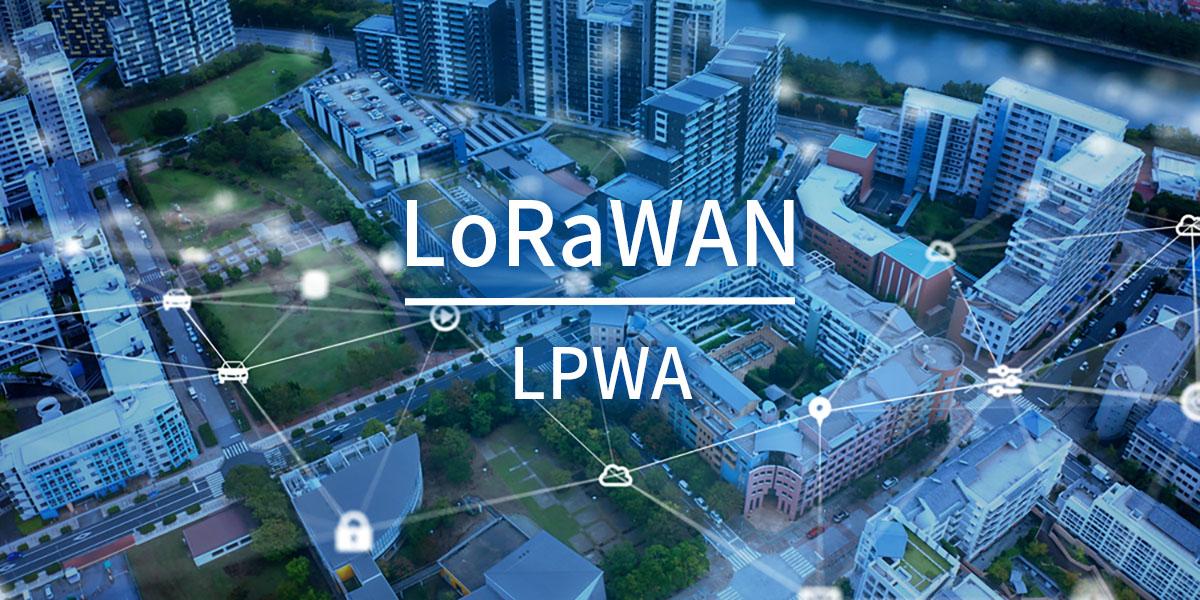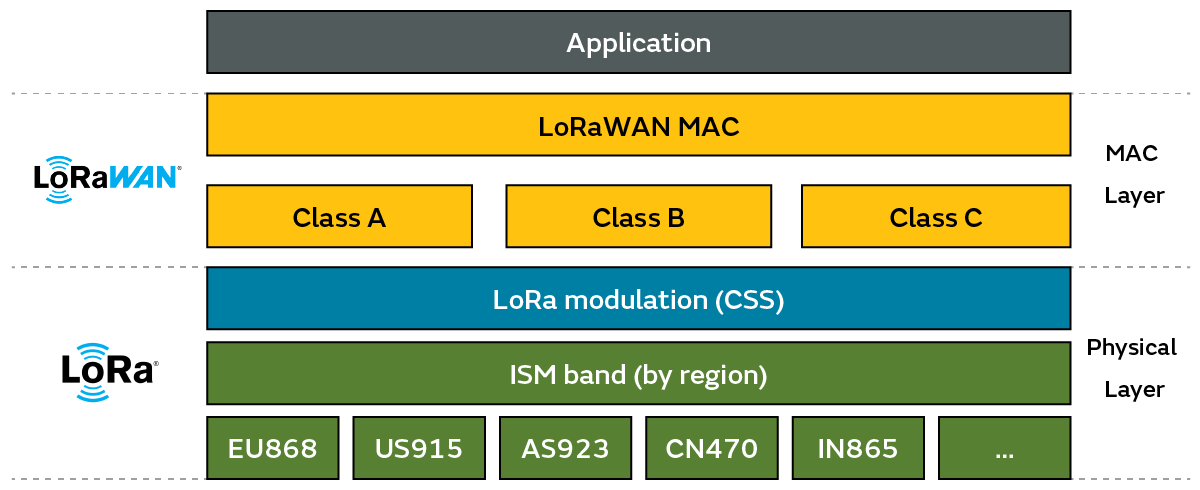LPWA Products LoRa (LoRaWAN) Modules


INDEX - LoRaWAN (Non-cellular LPWA) Primer – From Fundamentals to IoT Application Examples (1)
1.1 Comparison of LoRaWAN (Non-cellular LPWA) and Cellular LPWA
1.2 Primary LoRaWAN Applications
2. LoRaWAN Communication Protocol Stack – Roles of LoRa and LoRaWAN –
2.1 What is LoRa (Physical Layer)?
2.2 What is LoRaWAN (MAC Layer)?
3. LoRaWAN Network Construction – Configuration of the LPWA Devices, Gateway, Servers, etc. –
3.1 Example of Building Your Own LoRaWAN Network
INDEX - LoRaWAN (Non-cellular LPWA) Primer – From Fundamentals to IoT Application Examples (2)
4. Examples of IoT Solutions Utilizing LoRaWAN
5. LoRaWAN Modules From Murata Manufacturing
LoRaWAN is a standard within LPWA (Low Power Wide Area) wireless communication that uses the unlicensed band (sub-GHz band) that does not require a radio station license and features wide-area and long-distance communication as well as low speeds and low power consumption. LoRaWAN is a form of non-cellular LPWA that was established by the non-profit LoRa Alliance and recognized as an international standard by the International Telecommunication Union (ITU) in December 2021.
LoRaWAN is a wireless network system that is used by connecting one or a small number of gateways with many end devices*1 equipped with a LoRaWAN module. LoRaWAN does not require a carrier communications network and it enables companies to build and operate their own networks, which makes it easy to introduce regardless of the application and business scale, and the number of users is increasing every year.
*1 For example, communications devices that control device applications such as general lighting, cameras, and other sensors.
The LoRaWAN non-cellular LPWA standard is able to keep operating costs low compared to signing an agreement with a carrier and using their line. Furthermore, you do not need to consider the location where it will be used or whether stable communication with the carrier's base station is possible.
In addition, because it enables you to build a complete network environment on your own, LoRaWAN can implement a private and secure wireless communications environment that is not mediated by the lines of an external operator.
The primary applications of LoRaWAN include smart meters, smart cities, smart buildings, and enhancing the intelligence of public transportation in community infrastructure as well as support for IoT in the manufacturing industry, tracking of logistics cargo and people through location information, environmental sensing, smart agriculture, etc. Because it enables operation with a comparatively low cost that is not affected by the service area restrictions of carriers in contrast to cellular LPWA, LoRaWAN is attracting increased attention around the world as a means of wireless communication that is suitable for IoT and M2M in diverse fields.
The following page introduces several examples utilizing LoRaWAN.
4. Examples of IoT Solutions Utilizing LoRaWAN|LoRaWAN (Non-cellular LPWA) Primer – From Fundamentals to IoT Application Examples (2)
By looking at the communication protocol stack that is implemented, we can understand the features of those communication systems in many cases.
(The communication protocol stack is explained in the "Column – What Is the Communication Protocol Stack?" section at the bottom of this page.)
Figure 1 shows the LoRaWAN communication protocol stack. Here, we explain the LoRaWAN protocol stack as well as the respective meanings and roles of LoRa and LoRaWAN in the protocol.

The "LoRa" shown in the Physical Layer at the bottom of Figure 1 is an abbreviation of "Long Range" and refers to the wireless modulation method developed by U.S. company SEMTECH based on CSS (Chirp Spread Spectrum), which is a type of spectrum spread technique.
Furthermore, the LoRa ISM band*2 is established by country and region as shown in Table 1.
Region (country or territory) | Name | Frequency band (MHz) |
|---|---|---|
Europe | EU868/EU433 | 863-870/433-435 |
U.S. | US915 | 902-928 |
China | CN779/CN470 | 779-787/470-510 |
Japan | AS923 | 920-928 |
Australia | AU915 | 915-928 |
India | IN865 | 865-867 |
Indonesia | AS2 | 923-925 |
South Korea | KR920 | 920-923 |
Malaysia | AS1 | 920-923 |
New Zealand | AU915 | 915-928 |
Singapore | AS1 | 920-923 |
Taiwan | AS2 | 923-925 |
Thailand | AS2 | 923-925 |
*2 The ISM band is a frequency band established by the International Telecommunication Union (ITU) that can be used without a license in the fields of industry, science, medicine, etc. The ISM band includes frequency bands that are universal and those that are region (country and territory) specific. The latter type of band is established for LoRa.
The MAC*3 Layer LoRaWAN is the name of the non-cellular LPWA standard while also referring to the LoRaWAN network communication protocol (rules of communication). Under LoRaWAN, each end device connects to the gateway via the MAC (Device ID) without an IP to communicate wirelessly.
Moreover, the MAC options include Class A, Class B, and Class C, which differ in terms of the upstream and downstream communication schemes and intervals in the two‐way communication between each end device and the gateway as well as the switching behavior of the receiving slot on the device side related to power consumption, etc.
The low power consumption Class A is often used when running a device with a battery for a long period of time with little reception standby time on the device side. At the same time, other classes can be separately used according to the objective and environment such as when communicating with low latency while continuously supplying power to the device, etc.
*3 MAC is an abbreviation of "Media Access Control," and within the hierarchical communication protocols, it establishes methods for signal transmission timing control, the division of data to be transmitted, the assembly (transmission) and disassembly (reception) of frames with a destination address and other added control data, error detection, etc. in addition to the definition and allocation of the MAC address, which identifies devices.
Because LoRaWAN is a non-cellular LPWA standard, it does not use carrier base stations and communications networks, as is the case in the wireless communications of cellular LPWA devices.
Under LoRaWAN, data communication is carried out wirelessly between the LoRaWAN-compliant gateway and the end devices including sensors equipped with LoRaWAN modules, etc. Data is transmitted through this gateway to the network and application servers, etc., which run on communication protocols that differ from the LoRaWAN network.
The example below introduces a primary network built using LoRaWAN.
Because non-cellular LPWA does not require a radio station license, it enables companies to build a system on their own by preparing the LoRaWAN-compliant gateway, network servers, and application servers, etc. in addition to the end devices equipped with LoRaWAN modules.

As shown in Figure 2, the advantage of a LoRaWAN network is that it enables use of a private and secure wireless solution by building and operating the entire network oneself. Furthermore, while in some cases each server may be hosted on premises (internal environment), in other cases a cloud server contracted by the company may be used.
In cases where it is not suitable to build a LoRaWAN environment on your own, such as usage for a specific period of time or if you lack the internal system integration or networking personnel, an alternative method is to use a vendor who sells or rents gateways that support the LoRaWAN communication protocol and offers cloud services, etc.

As shown in Figure 3, there are cases in which a company may sign a fee-based contract with a vendor for a LoRaWAN-compliant gateway and network servers or application servers according to the circumstances. The service details differ by vendor, but the ability to entrust the gateway implementation, server maintenance, etc. to the vendor is an advantage of such contracts.
Furthermore, when it comes to LoRaWAN-compliant gateways that can connect and communicate with many devices, there are gateways that can only be used by the subscriber as well as plans that reduce usage fees by sharing a gateway between multiple subscribers.
Moreover, cloud services are typically provided with the exception of the gateway. A monthly fee is required when subscribing to a gateway and servers. However, compared to cellular LPWA, which requires a mandatory contract with a carrier to use the cellular phone communication network, the service usage fees for network server vendors, etc. required to operate the LoRaWAN non-cellular LPWA standard are said to be low.
Regardless of whether they are wireless or wired, telecommunications function by conforming to communication protocols (Reference: 6. What Is a Communication Protocol?|Basic Knowledge of Wireless Communication: Wireless Mechanism (2)). Table 2 shows the role and correspondence of each layer of the communication protocol stack in the LoRaWAN model and the OSI Reference Model*4.
| OSI Reference Model | Roles and Examples | LoRaWAN model | |
|---|---|---|---|
| Application Layer | Defines the functions that are required as an application such as sending and receiving files, etc. (HTTP, FTP, DNS, SMTP, POP, etc.) | Application | |
| Presentation Layer | Defines (SMTP, FTP, Telnet, etc.) the data expression format (encryption method, character code, etc.) | - | |
| Session Layer | Defines the steps related to the start and end (login and logout, etc.) of communication (TLS, NetBIOS, etc.) | ||
| Transport Layer | Rules that ensure communication quality such as error detection and recovery in transmitted and received data (TCP, UDP, NetWare/IP etc.) | ||
| Network Layer | Defines functions for relaying to different networks (IP, ARP, etc.) | ||
| Data Link Layer | MAC Layer | Defines the control procedures for transferring data (Ethernet, etc.) | LoRaWAN MAC (Class A / Class B / Class C) |
| LLC Layer | - | ||
| Physical Layer | Defines connector shapes and other physical specifications (RS232C, etc.) for transferring data to communication channels as well as modulation systems in the case of wireless | LoRa modulation | |
*4 The OSI Reference Model is an international standard model for a protocol stack. Currently, the protocol stack of this model is not directly used. However, because it is the fundamental reference model for the protocol stack, it is often compared to the various protocols that are implemented in devices.
Table 2 shows that the LoRaWAN model stack has three layers while the TCP/IP model, which is the communication protocol of the Internet, has four layers, so we can see that the LoRaWAN model has a simpler protocol configuration. This means that it is easier to update the protocol and leads to improved response times.
INDEX - LoRaWAN (Non-cellular LPWA) Primer – From Fundamentals to IoT Application Examples (2)
4. Examples of IoT Solutions Utilizing LoRaWAN
4.1 Disaster Prevention System Using LoRaWAN and Environmental Monitoring Sensors
4.2 Smart Agriculture Using LoRaWAN and Soil Sensors
4.3 Community Infrastructure Smart Meters Using LoRaWAN
4.4 Adding Intelligence to a Solar Power Plant Using LoRaWAN
5. LoRaWAN Modules From Murata Manufacturing
5.1 Features of the LoRaWAN Modules From Murata Manufacturing
5.2 Lineup of LoRaWAN Modules